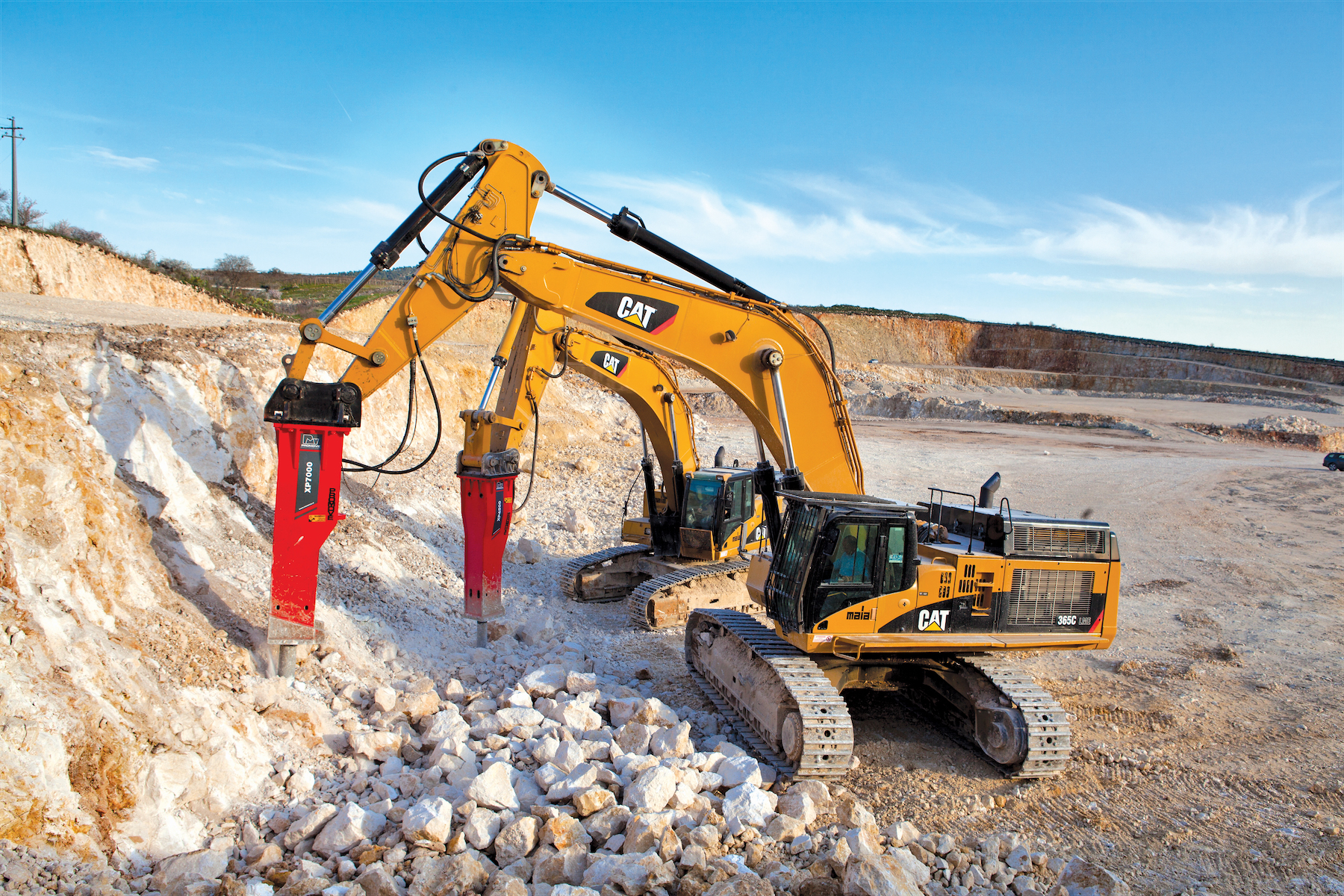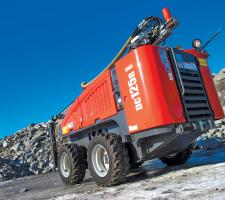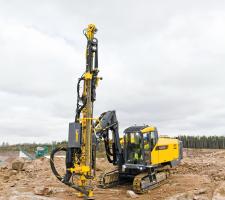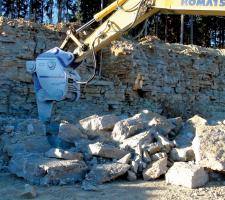
When blasting is not a viable option in a quarry a large-sized excavator equipped with a heavy, powerful breaker can be the answer. Patrick Smith reports
Law regulations or the proximity of houses or other buildings may mean drill and blast is not possible in some quarries.
Breaker manufacturer
“When high productivity becomes a key driver, increased size of machines used on the front line is the only way to get adequate production, keeping production costs under control,” says Antonio Cannao, commercial director of Promove.
While once such breakers were looked on as auxiliary equipment to be used after drill and blast to further reduce rocks for crushing, manufacturers, including Promove, are claiming that large breakers can offer advantages on production, costs and the quality of the material.
Hydraulic breakers are also often used as standard in the secondary reduction of oversize boulders in the rock pile. Mounting a breaker on a mobile carrier is said to provide a unit that can be used at several points in the quarry.
“The breaker is a very important tool on the jobsite. It is always in the front line and has a complex and costly organisation behind it: excavators, loaders, trucks, crushers and men. Its breaking performance (broken rock on the ground is money) and reliability must be at top level to keep the organisation running without costly downtimes,” says Cannao.
For operations with an output of up to 600,000tonnes/year, feasibility studies should be carried out to show whether the use of heavy duty hydraulic breakers represents an economic alternative to drilling and blasting, says
“There are no two identical quarries anywhere in the world, so whether the use of hydraulic breakers represents a viable alternative has to be analysed on a case-by-case basis,” says the company.
Breakers can guarantee continuous production, whereas using explosives requires various stages and long downtimes such as preparation of the rounds, distancing of personnel and cessation of activities, says
“Add to this, when mining very precious material the breaker minimises the quantity of waste inevitably produced by explosives. The breaker can also create the profiles necessary for environmental restoration, today a critical requirement for any mining activity, while it also performs the primary crushing.
“The breaker substantially reduces the problems caused by explosives disturbing communities in areas surrounding the quarry.”
The company also claims that in the medium and long term the hourly cost of an operator and of an 80-100tonne excavator fitted with a large breaker (underlining the importance of machinery size in cost-to-benefit ratios) offers a substantial reduction in production costs with respect to the operating cycle performed with explosives.
However, many quarry companies still use drill and blast for rock extraction, and are turning their attention to reducing costs while increasing safety and lessening the impact on the environment.
A worldwide
For example, Atlas Copco, which has introduced a number of new breakers, has introduced a new top hammer surface drill rig, the FlexiROC T45, along with its new rock drill COP 3060. The company says the new rig follows its predecessor, the ROC F9, and was to be built on a tried and trusted platform that would provide high availability and a wide area of use for both large and small applications.
Field studies are said to show that the FlexiROC T45 with folding boom, depending upon rock conditions, uses less fuel than the ROC F9 using the same rock drill.
“It is an incredible accomplishment to increase productivity and drilling capacity while reducing fuel consumption so dramatically. Everybody wins when there is less environmental impact, a better working environment, and higher profitability,” says Mario Santillan, product manager at Atlas Copco Surface Drilling Equipment.
The field tests were carried out by international high technology mineral group LKAB (Luossavaara-Kiirunavaara AB) in Svappavaara, Sweden. The tests, at the open pit mine above the Arctic Circle, logged 500 impact hours; 200 hammer hours; and a total of 12,500m drilled with an average hole diameter of 89mm and an average depth of 15m.
“The purpose of these trials is to test our new solutions in real job environments, so that we know they really work when we start selling them. These trials have gone extremely well,” says Patrik Lindqvist, service technician for Atlas Copco surface drilling.
“This machine has a Tier 4 engine with exhaust purification and only uses 24litres/hour as compared to 35litres for the ROC F9. That reduction of almost a third means a lot when it comes to operational costs and CO2 emissions.”
Meanwhile, the company’s MB Essential range reduces breaker features to the essential to manage their daily targets. Service weights for the range of five machines is from 750kg to 1,700kg, and carrier weights vary from 10-17tonnes up to 19-32tonnes.
Atlas Copco Construction Tools has introduced a range of five C-Series hydraulic breakers, specifically for the Chinese construction market. The basic breakers are designed to work with carrier machines in the 4-50tonne class, and have a slim box design with vibration dampening technology.
“China is the only construction market in the world which is dominated by the basic breaker segment,” says Torsten Ahr, marketing manager for Atlas Copco’s hydraulic attachments.
“Our C-Series is the perfect complement to our existing product portfolio in this market. They will not replace the premium light, medium and heavy hydraulic breakers that Atlas Copco is known for.
“The C-Series is a range of easy to operate, highly durable breakers, which together with the premium range will provide the optimal match for the Chinese construction market.”
The fully remote-controlled, hydraulic and self-propelled mini-sized drilling unit on a four-wheel drive carrier, is for drilling 22–45mm holes, and replaces the former Sandvik DC122R, one in the series of rigs originally launched in 1988 under the product name of Tamrock Commando.
The company claims that trials show the new model offers better manoeuvrability than before, due to new large drive gears, while rough terrain safety is also said to be improved.
Highly mobile and versatile, the Sandvik DC125R mini rig can be used in duties such as road cutting, line drilling in dimensional stone quarries, and other special drilling applications, says Sandvik.
Also new from Sandvik is the larger 24tonne DI 550 DTH rig, which is a true production drill for blasthole drilling in medium-large quarrying applications. It can be used to drill holes with diameters from 89-165mm and use DTH hammers of 76, 102, 127 and 152mm.
Last year’s revival of
The new small range models, 255, 355 and 455, are suitable for 1.2-5.2tonne carriers, and feature Rammer’s constant blow energy (CBE) operating design that ensures constant impact energy for every blow.
The 5011 is designed for use with carrier machines in the 43-80tonne class, slotting into Rammer’s line-up between the 4099 and the proven 7013. The breaker incorporates a number of features from the company’s smaller hammers, allowing customers to tailor its use to specific applications.
Meanwhile, Promove provides an example where its XP7000 breaker, with a service weight of 6.9tonnes, is at work in a quarry, “the task it was made for.”
After using an XP4500 on a
“When high productivity becomes a key driver, increased size of machines used on the front line is the only way to get adequate production while keeping production costs under control,” says Cannao.
“With this reference, the XP7000 shows positive features: productivity in an eight-hour shift can vary from 400m³ to more than 2,000m³ according to the hardness of the rock.
“A satisfying average daily production of 1,200m³ was gained in this quarry on the 1,300kg/cm2 stratified white limestone shown in the pictures.
“The main use of this class of hydraulic hammer is primary breaking on the front line. In this application, heavy breakers can maximise the value of the combination of tool-machine-driver, delivering the highest value of production per capital invested.”
With its blank-firing prevention system the XP7000 can also be safely used for reducing oversizes.
“Extremely dusty and hot environments are now exalting the technical features of this percussion giant, hitting with 17,700 joules on a 210mm chisel,” says Cannao.
Peter Fahey of Caterpillar Work Tools points to the new E Series hammers which were launched recently by the company.
“This is a new venture for Cat. These hammers are Cat designed, engineered and manufactured,” says Fahey.
“They were designed for heavy-duty applications in quarries, excavation, demolition and road construction,” he told dealers and customers at the recent international Quarry Days event in Malaga, Spain.
“The E Series hammers can be related closely to our carrier machines.”
Only recently, Caterpillar added three new models to the series: H140Es, H160Es and H180Es for use on medium and large excavators. The energy classes of the H140Es, H160Es and H18Es are 8,135 joules, 11,525 joules and 16,270 joules respectively, and the new hammers match up with Cat excavators ranging from the 324E to the 374D L. Mounting brackets are available for Cat quick couplers.
The E Series hammers feature a new symmetrical housing design, which allows rotating the housing 180º to compensate for wear, effectively extending the life of the housing.
“The lower portion incorporates rock edges that add protection to the housing and enable quick positioning of boulders. An optional wear package is available to further enhance hammer durability in severe applications.”
The series builds on the proven D Series hammers, which the new hammers replace. Features include automatic shut-off, which instantly stops the hammer when the tool breaks through material.
“The system increases hammer reliability and durability by eliminating the high internal stresses created by blank firing.”
Earlier this year,
During the first half period of 2013, Komatsu said it was going to launch the sales of nine models designed to fit 7-150tonne excavators, starting in China and the United States where strong demand is projected. Following these initial sales, Komatsu plans to engage in worldwide sales.
The Xcentric Ripper is used with hydraulic excavators in a variety of work including quarrying, and at bauma 2013 it said six new models of the attachment had been developed.
The various-sized hydraulic breakers are being used in quarries across Europe and other parts of the world including Russia, Australia, Canada, Latin America, South-East Asia, Middle East and Africa.
The product’s manufacturer, also called Xcentric Ripper, says its hydraulic breakers are the perfect tool to increase production, reduce noise and save running and maintenance cost. The standard Xcentric Ripper product line is now said to be completed with the nine models, although custom-made versions of the Xcentric Ripper can be produced for large mining or dredging projects for excavators up to 600tonnes.
“It is a new technology and we are the only one to make this product,” says sales director Dick van der Starre.
“The Xcentric Ripper is specially designed to work in excavation work and trenching in rock.
“It is driven by two hydraulic motors impacting and breaking the rock. After that you can pull the rock out with the power of the excavator.”
Another manufacturer,
The DXB100H breaker, with an operating weight of 900kg and a blow energy of 2,350 joules, is suitable for Doosan excavators up to 18tonnes (DX140LC, DX140LCR, DX160LC crawler excavators/DX140W, DX160W and DX170W wheeled excavators).
Designed for use on Doosan excavators from 20-28tonnes, the DXB170H breaker (operating weight of 1,620kg and blow energy of 3,400 joules) is approved for use on the DX210W wheeled excavator and all the medium Doosan crawler excavators from the DX225LC to the DX255LC.
The Doosan DXB260H breaker, with an operating weight of 2,450kg and a blow energy of 5,000 joules, is suitable for the Doosan excavators from 30-34tonnes (DX300LC and DX340LC models)
“The new breakers, intended for demolition, construction and mining applications, offer many important features: a simple, robust design providing both economical and reliable performance, low maintenance costs, operator comfort and carrier protection,” says Doosan.
“DXB technology ensures the carrier is protected from the effects of reduction in pressure peaks. The breakers include an energy recovery system and a patented valve system, increasing overall performance; a high quality piston and cylinder manufactured to precise tolerances, and an advanced dampening system to protect the breakers against blank firing. The close tolerances of the parts used in the breakers result in lower maintenance costs.”


















